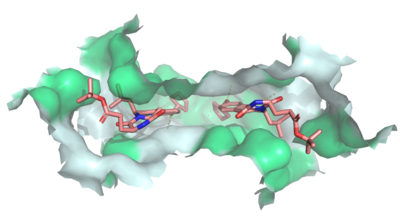Sandbox Reserved 1613
From Proteopedia
(Difference between revisions)
| Line 22: | Line 22: | ||
<ref name="Manolaridis">PMID:30405239</ref> | <ref name="Manolaridis">PMID:30405239</ref> | ||
===Transmembrane Domains=== | ===Transmembrane Domains=== | ||
| - | In the transmembrane domain is located the leucine plug that separates the first site of binding from the second site of binding for the substrate. Both domains are stabilized by several interactions both intermolecularly. The first and most prominent feature of the TMD is EL-3. This loop which extends out from the transmembrane domain has been shown to be involved in stabilization of the TMD's. A member of the same subfamily, ABCG5/ABCG8, was shown to have <scene name='83/832939/El-3_of_abcg5_abcg8/1'>EL-3 helices</scene> that extended further into the extracellular space. This condensed helices is one of the defining features of ABCG2 transporter protein. The EL-3 of ABCG2 is stabilized by both intermolecular and intramolecular disulfide bonds at <scene name='83/832939/Disulfide_bonding_interactions/1'>592, 608 and between Cys 603</scene> of each domain. | + | In the transmembrane domain is located the leucine plug that separates the first site of binding from the second site of binding for the substrate. Both domains are stabilized by several interactions both intermolecularly. The first and most prominent feature of the TMD is EL-3. This loop which extends out from the transmembrane domain has been shown to be involved in stabilization of the TMD's. A member of the same subfamily, ABCG5/ABCG8, was shown to have <scene name='83/832939/El-3_of_abcg5_abcg8/1'>EL-3 helices</scene> that extended further into the extracellular space. This condensed helices is one of the defining features of ABCG2 transporter protein. The EL-3 of ABCG2 is stabilized by both intermolecular and intramolecular disulfide bonds at <scene name='83/832939/Disulfide_bonding_interactions/1'>592, 608 and between Cys 603</scene> of each domain. Even with the stabilization of the disulfide bonds, it has been discovered that without glycosylation at <scene name='83/832939/6ffc-glycosylation/1'>N 596</scene>, ABCG2 does not mature and is ubiquitin tagged for degredation. |
===Nucleotide Binding Domains=== | ===Nucleotide Binding Domains=== | ||
These two domains contain the active site of this transporter protein. The interest in this protein is in its involvement with mutidrug resistant cancer cells. This involvement is due to its active site's promiscuity as many xenobiotics have been found to transported to the outside of the cell by this transporter. | These two domains contain the active site of this transporter protein. The interest in this protein is in its involvement with mutidrug resistant cancer cells. This involvement is due to its active site's promiscuity as many xenobiotics have been found to transported to the outside of the cell by this transporter. | ||
Revision as of 09:59, 21 April 2020
ABCG2 Transporter Protein
| |||||||||||
References
- ↑ Jackson SM, Manolaridis I, Kowal J, Zechner M, Taylor NMI, Bause M, Bauer S, Bartholomaeus R, Bernhardt G, Koenig B, Buschauer A, Stahlberg H, Altmann KH, Locher KP. Structural basis of small-molecule inhibition of human multidrug transporter ABCG2. Nat Struct Mol Biol. 2018 Apr;25(4):333-340. doi: 10.1038/s41594-018-0049-1. Epub, 2018 Apr 2. PMID:29610494 doi:http://dx.doi.org/10.1038/s41594-018-0049-1
- ↑ Manolaridis I, Jackson SM, Taylor NMI, Kowal J, Stahlberg H, Locher KP. Cryo-EM structures of a human ABCG2 mutant trapped in ATP-bound and substrate-bound states. Nature. 2018 Nov;563(7731):426-430. doi: 10.1038/s41586-018-0680-3. Epub 2018 Nov, 7. PMID:30405239 doi:http://dx.doi.org/10.1038/s41586-018-0680-3
- ↑ Fetsch PA, Abati A, Litman T, Morisaki K, Honjo Y, Mittal K, Bates SE. Localization of the ABCG2 mitoxantrone resistance-associated protein in normal tissues. Cancer Lett. 2006 Apr 8;235(1):84-92. doi: 10.1016/j.canlet.2005.04.024. Epub, 2005 Jun 28. PMID:15990223 doi:http://dx.doi.org/10.1016/j.canlet.2005.04.024
- ↑ Taylor NMI, Manolaridis I, Jackson SM, Kowal J, Stahlberg H, Locher KP. Structure of the human multidrug transporter ABCG2. Nature. 2017 Jun 22;546(7659):504-509. doi: 10.1038/nature22345. Epub 2017 May, 29. PMID:28554189 doi:http://dx.doi.org/10.1038/nature22345
- ↑ Cleophas MC, Joosten LA, Stamp LK, Dalbeth N, Woodward OM, Merriman TR. ABCG2 polymorphisms in gout: insights into disease susceptibility and treatment approaches. Pharmgenomics Pers Med. 2017 Apr 20;10:129-142. doi: 10.2147/PGPM.S105854., eCollection 2017. PMID:28461764 doi:http://dx.doi.org/10.2147/PGPM.S105854
- ↑ [ https://en.wikipedia.org/wiki/ABCG2 "ABCG2 -." Wikipedia, the Free Encyclopedia. Web. 20 Apr. 2020].
- ↑ Jackson SM, Manolaridis I, Kowal J, Zechner M, Taylor NMI, Bause M, Bauer S, Bartholomaeus R, Bernhardt G, Koenig B, Buschauer A, Stahlberg H, Altmann KH, Locher KP. Structural basis of small-molecule inhibition of human multidrug transporter ABCG2. Nat Struct Mol Biol. 2018 Apr;25(4):333-340. doi: 10.1038/s41594-018-0049-1. Epub, 2018 Apr 2. PMID:29610494 doi:http://dx.doi.org/10.1038/s41594-018-0049-1
Student Contributors
Shelby Skaggs, Samuel Sullivan, Jaelyn Voyles

